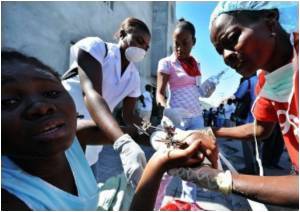The first 'isolated' cases of cholera were reported in the Haitian capital, amid fears Tuesday that last weekend's hurricane rains will hasten the spread of the disease in Port-au-Prince's

"It's coming," Henry warned, adding that two deaths believed to have been caused by cholera were being probed by health officials, who planned a press conference in Port-au-Prince later Tuesday to discuss the developments.
Health authorities fear that cholera could infiltrate the cramped, unsanitary Port-au-Prince camps where hundreds of thousands of people who bathe, wash and cook right next to each other, run the risk of spreading the ailment like wildfire.
The Haitian capital for weeks had evaded the epidemic, but Hurricane Tomas appears to have contributed to its arrival here, after the storm-swollen Artibonite River -- the presumed source of the outbreak -- overflowed its banks over the weekend.
Tomas barreled into Haiti on Friday, bringing torrential rains and packing winds up to 85 miles (135 kilometers) per hour.
In the end, the capital was spared the brunt of the storm, but Tomas submerged coastal towns like Leogane in floodwaters, triggered dangerous mudslides inland and wiped out roads and bridges, completely cutting off some rural communities from help.
Advertisement
As the storm approached, thousands of displaced people scrambled onto buses to evacuate the flimsy tents and tarpaulin sheets of the cramped refugee camps around Port-au-Prince.
Advertisement
Tomas was just the latest in a series of heavy blows for besieged Haiti in the wake of January's quake that killed 250,000 people and left more than a million homeless -- many of them forced to live in the country's fetid tent cities.
Now the cholera epidemic, in addition to causing hundreds of deaths in Haiti's provinces, has sent more than 8,000 people to the hospital.
Although easily treated, the water-borne bacterial disease has a short incubation period and causes acute diarrhea that can quickly lead to severe dehydration and death.
Meanwhile, aid groups worried about remote areas where residents don't have access to clinics or hospitals.
"Outside of the larger population centers, it is critical that smaller, dispersed communities are able to access treatment," said Kate Alberti, an epidemiologist working for Doctors Without Borders.
"We are very concerned about the spread of the epidemic in rural areas, where transport to existing health structures is difficult," Alberti said.
"Treatment centers need to be established and existing ones further supported in order to ensure rapid access to treatment."
Source-AFP












